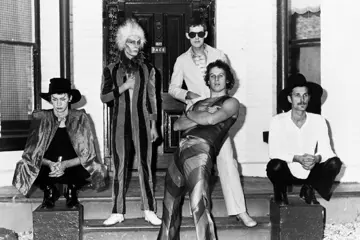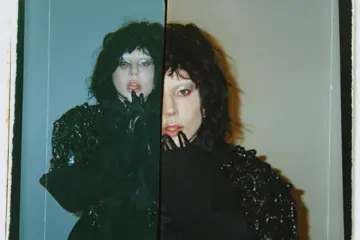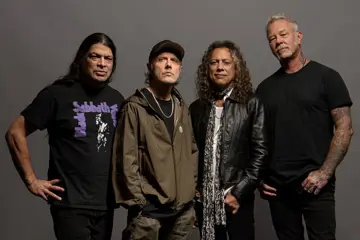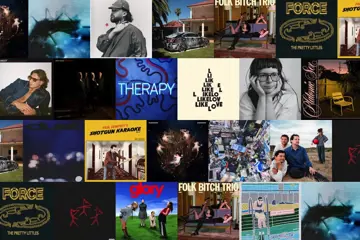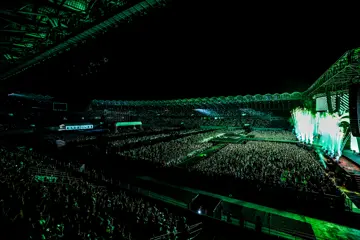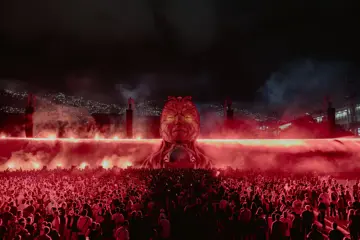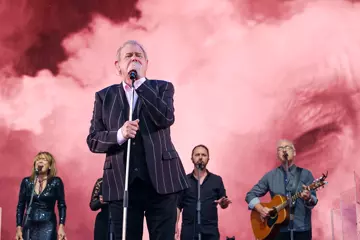Today's the day!
At long last, after putting up with literal years' worth of poorly Photoshopped images claiming the occasion for myriad arbitrary dates in recent memory, we have reached the real, official, proper day that Back To The Future heroes Marty McFly and Doctor Emmett 'Doc' Brown landed in the far-off year of 2015, as seen in Back To The Future, Part II — at 4.29pm, 21 October.
Of course, the excitement surrounding the arrival of today has reached fever pitch in the past week, as the internet has thrown up countless videos and think-pieces about what Back To The Future got right and wrong about the distant days of the 21st century (aka the present). Somewhat unsurprisingly, most have come to the conclusion that our future — lacking the hoverboards, ultra-quick enlarging pizza and obvious fashion expertise of its fictional counterpart — kind of sucks compared with the fictional alternative, but we're less easily convinced.
Sure, the real 2015 is an imperfect place, full of shitty things and shittier humans, but, beneath the stylish rainbow caps and self-fitting, self-drying clothes of Hill Valley's imagined future, there's a seedy, inextricable layer of dystopian terror that permeates every street corner and above, and makes us considerably less willing to accept the projected perfection of Back To The Future's vision being touted by many commentators.
For example, our 2015 is objectively better than Back To The Future II's because…
There Are No Flying Cars
When Marty and Doc first arrive in the future, they appear in a sky filled with traffic, as everyday workers make their way across the air in their fancy flying automobiles. Ostensibly, this seems like a great development, theoretically at least halving travel times and freeing up traffic jams with not only multiple lanes, but several layers thereof.
But think about it — have you driven, or been in a car or anywhere near a road lately? Have you looked at our national road toll? If you've done any of these things, then you know that vehicle drivers — of which I am one, so I say this with authority — are uniformly terrible and wildly unpredictable creatures, frequently maneuvering according to seemingly random divine forces that compel them to swing across lanes without indicating or floor it down the merging lane because they and they alone are genius enough to recognise that their reckless behaviour will ensure them a spot all of two places higher in the jam than they would have been if they'd just merged like a normal human. Maybe they'll flip you off for good measure, so you definitely know that whatever just happened was your fault.

And you want to give these people the power of flight? Where road rage incidents suddenly involve the very real risk of death-by-freefall, and lane changes take on an additional whole dimension on top of just "left or right"? No. No, thank you.
we still have lawyers
Upon (accidentally) completing his mission to spare his future-son from a life behind bars for theft, Marty is told by Doc that the US justice system "works swiftly now that they've abolished all lawyers", but we also see pretty much immediately the horrifying implications of a world without our much-maligned legal reps, which — contrary to what Lionel Hutz once imagined — is a far cry from the end result being everyone standing around holding hands and singing folk songs.
Once Marty "corrects" (or alters for his own purposes) future history to ensure his boy doesn't end up doing hard time, a USA Today headline changes from Youth Jailed: Martin McFly Junior Arrested For Theft to Gang Jailed: Hoverboard Rampage Destroys Courthouse.


So here we have, in one case, Marty's kid going to prison for being complicit — unwillingly, yes — in a co-ordinated theft effort for "an undisclosed cash amount", while, in the other, we have a group of teenagers earning the same fate for, as far as anybody knows, entirely accidentally riding their hoverboards through the window of a courthouse. Those are two very different crimes, yet they both yielded the same result for the accused, because this is some Judge Dredd courtroom efficiency going on here.
Sure, the "reckless" hoverboard "rampage" was, according to the article, "in violation of a local ordinance", but considering the same article admits "no one was injured" and the damage seemed to be contained to windows, rather than extending to historic stone surfaces or what have you, surely this rates pretty low on the "malicious destruction of public property" ladder. But, instead of getting a fine or community service or some other slap on the wrist for being hooligans — as they would have, were they represented by some shrewd suit-wearer who knows their way around a loophole or two — they end up with actual jail time. That's… not great.
there are no neon curb lights

While we can at least appreciate the good intention behind lining street curbs with blue and red lighting to indicate whether or not one is able to park their carplane in that particular spot, something tells us that flooding entire neighbourhoods with garish neon illumination wouldn't do wonders for the quality of rest in those places.

Really, though, it's hard enough to get a good night's sleep as it is — our poor bodies are already contending with constant noise from planes, trains, automobiles, smartphones, pets, those nymphomaniac septuagenarians that moved in next door last July, and the annoying-but-not-frequent-enough-to-fix dripping of your shower head. We simply don't need neighbourhood neons added to that equation, especially since it's likely they were only added to accommodate the landings of those goddamn flying cars in the first place, which is just another way that airborne traffic will do nothing but screw you.
there is no jaws 19
While Back To The Future II may have been correct to assume that 3D movies and franchise exploitation would be a thing in 2015, at least we can take solace in the fact that, outside of James Bond films and a very select few other properties, no singular premise has been bled for 19 movies straight, yet. We'll concede that Marvel's shared universe will undoubtedly clear 19 films in its lifetime but, still, it's better than a reality in which some studio execs found (diminishing) returns in the increasingly unlikely personal vendettas of sharks. Even Freddie Kreuger and Jason Voorhees — both of whom possess self-awareness and an understanding of concepts like murderous vengeance, where, you'll note, sharks do not — had stumps called on their original franchises well before hitting the high teens.

If the existence of a real Jaws 19 were to have any kind of positive implication for reality, it would be the fact that at least Steven Spielberg would have been justified in throwing his own son under the bus by slapping his name under the "directed by" credit (click the pic to enlarge). Poor Max Spielberg never actually made Jaws 19, but I hate him for it anyway.
The other positive to arise from the fact that this film does not exist is that it gave the Super Bowl's creative directors the freedom to pinch its art style and give us a real icon for our time.

there are no double ties

What is this? How did it come about? I understand the general idea behind several of the fictional 2015's technological developments. But, out of all the movie's questionable assumptions about 21st-century technology and fashion, this is the most unbearable. I would happily wear Griff's lump-helmet and deal with a world where the equivalent of Google Glass hadn't been immediately laughed off for the knobbish wankery that it is to have been able to assume a casual acceptance at the dining-room table, but, honestly, one necktie is already the acme of discomfort. There is absolutely zero need or reason to double-up on that shit unless you are quietly trying to choke the life out of yourself on a daily basis.
Which, actually, would make sense, now that we think about it, given how much this alternative future obviously suuuuuuucks.
Welcome to 2015, Marty and Doc. We hope it's better than you thought it'd be.



